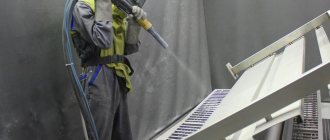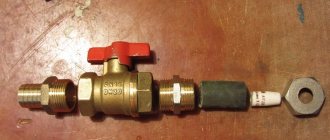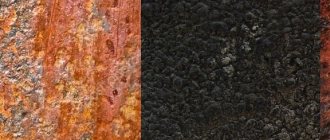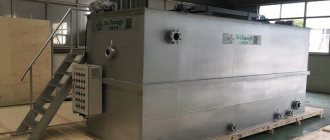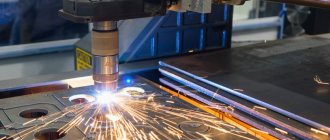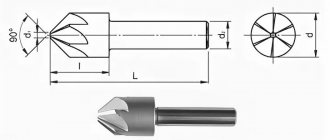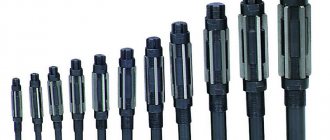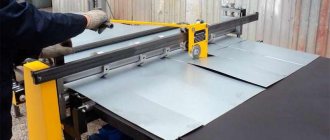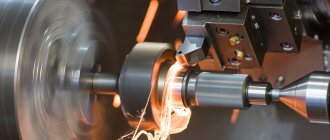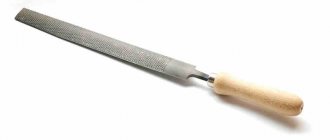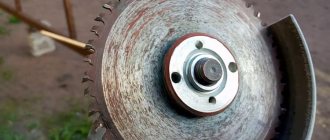In order to clean the surface of the product from various types of contaminants (old paintwork, rust), abrasive blasting (sandblasting or shot blasting of parts) is used. Deep cleaning of the metal surface is necessary for maximum adhesion of the new paint coating to the base. When powder painting, sandblasting is included in the list of mandatory actions. This is the modern methodology for painting and sandblasting in Moscow.
In our company, shot blasting of metal is performed as a preparatory step for any further processing. The main difference between shot blasting and sandblasting is the abrasive material used during cleaning. To process metal surfaces we use cooper slag, nickel slag, cast iron and steel shot. A special device effectively removes everything unnecessary, including various hardened particles. In its own habitable chamber, not only shot blasting of discs is carried out, but also careful processing of products with large dimensions. Shot blasting and painting is carried out by qualified craftsmen using modern equipment.
We work with various types of products:
- wheel disks;
- pipes and other long products;
- automobile bodies;
- engine and chassis parts;
- other metal products (steel, copper, aluminum).
8Experiment to determine the loss of compressed air pressure in sandblasting hoses
Equipment used for testing:
- Compressor: capacity 16.8 m3/min (rotary compressor)
- Blower: pneumatic sandblaster
- Tank capacity: 300 kg
- Piping system on tank: internal diameter 1 1/4″ (32 mm)
- Jet nozzles: Boron carbide Venturi nozzles
- Jet Hose: 1 1/4″ (32mm) ID with special quick connects
The pressure loss measurements carried out with the above equipment were carried out at different diameters of the air supply hose. The pressure loss in a sandblasting hose was determined with a constant internal diameter but varying length, with/or without a hand hose. Test No. 1 Dimensions of the air hose: length 15 m - internal diameter 19 mm Dimensions of the abrasive blasting hose: various lengths - according to the table - internal diameter - 32 mm Dimensions of the hand hose: length 3.5 m - internal diameter 25 mm
Experimental measurement results
| Nozzle size | Compressor pressure | Pressure in sandblaster | Pressure at the sandblasting nozzle in atm at the blasting hose with an internal diameter of 32 mm and length | |||
| 19 m | 34 m | 49 m | ||||
| mm | inch | atm | atm | atm | atm | atm |
| 8 | 5/16 | 7,1 | 7,1 | 6,8 | 6,3 | 6,2 |
| 9,5 | 3/8 | 7,1 | 7,0 | 6,4 | 5,9 | 5,7 |
| 11 | 7/16 | 7,1 | 7,0 | 6,3 | 5,3 | 5,0 |
Test No. 2. The test procedure is almost the same as test No. 1, however Air hose dimensions: length 15 m - internal diameter 32 mm Jet hose dimensions: various lengths - according to the table - internal d.32 mm Hand hose dimensions: length 3.5 m - internal diameter 25 mm
Measurement result
| Nozzle size | Compressor pressure | Pressure in sandblaster | Pressure at the jet nozzle in atm at the jet hose with an internal diameter of 32 mm and length | |||
| 19 m | 34 m | 49 m | ||||
| mm | inch | atm | atm | atm | atm | atm |
| 8 | 5/16 | 7,1 | 6,2 | 6,0 | 5,4 | 5,0 |
| 9,5 | 3/8 | 7,1 | 5,5 | 5,2 | 4,5 | 4,2 |
| 11 | 7/16 | 7,1 | 4,5 | 4,2 | 3,7 | 3,5 |
| 12 | 1/2 | 7,1 | 6,9 | 5,0 | 4,7 | 4,3 |
CONCLUSION:
The experimental results prove that large diameter hoses have an advantage over small diameter hoses.
9KPDU – remote control of sandblasting machine
Only two operators together can ensure full operation of the sandblasting machine. The first sandblasting operator directly performs surface treatment, and the second worker turns the sandblasting machine on or off at the command of a colleague.
Remote control completely replaces the functionality of a second assistant worker and increases the safety of sandblasting. The remote control device for sandblasting apparatus (KPDU) is universal; it can be used with pressure-type sandblasting units of any manufacturer.
To start the sandblasting machine, you need to press the button on the sandblasting arm and do not release it. Thus, you open the air inlet valve on the tank and automatically, at the same moment, the air outlet valve closes, and a stream of abrasive begins to be ejected from the abrasive hose. The response time of the remote control button is no more than 1 second. If for some reason the sandblasting operator loses control of the process, for example, he stumbles, becomes ill or loses consciousness, then sandblasting will stop the moment he releases the button. This guarantees the complete safety of the sandblaster and the people around him and is excellent protection against a trip to the emergency room. Our remote control ensures reliability and safety even when sandblasting in hazardous areas. In addition to safety, the KPDU significantly saves abrasive material and compressed air, since the sandblasting operator does not need to wait until someone turns off the compressed air supply. Also, significant savings occur due to the refusal to attract additional employees.
Full description and technical characteristics of a pneumatic valve with remote control (KPDU)
Look
Price list for metal sandblasting service
| Type of work | Price (per m2) | |
| Sandblasting of metal structures | from 550 rub. | Order |
| Sandblasting of metal structures against corrosion | from 550 rub. | Order |
| Sandblasting cleaning of metal structures from paint (not powder) | from 600 rub. | Order |
| Sandblasting of ferrous sheet metal | from 500 rub. | Order |
| Sandblasting of ferrous sheet metal from corrosion (rust) | from 500 rub. | Order |
| Sandblasting cleaning of sheet metal from paint (not powder) | from 550 rub. | Order |
| Sandblasting metal grating | from 600 rub. | Order |
| Sandblasting metal grating from corrosion (rust) | from 600 rub. | Order |
| Sandblasting of forged products on both sides more details | from 1000 rub. | Order |
| Sandblasting stainless steel sheets | from 600 rub. | Order |
| Sandblasting of stainless steel sheets after rolling | from 600 rub. | Order |
| Sandblasting of ferrous sheet metal from scale | from 700 rub. | Order |
| Sandblasting of metal grating painted with powder paint | from 1000 rub. | Order |
| Removing paintwork | from 700 rub. | Order |
11The undeniable advantages of quick-release connections
Connect sandblasting hoses to each other and to the system without reducing the diameter of the blasting hose. Always choose quick connect couplings that are mounted on the outside of the hose, since couplings that are mounted on the inside of the hose narrow the hose diameter by almost half. This results in a reduction in air flow of almost 50%. Also, due to the contact of the abrasive material under air pressure with the edge of the internal joint, turbulence is formed, which leads to a loss of pressure and rapid wear of the internal walls of the sandblasting hose. Use quick connectors.
Example from life:
If you use regular hose fittings, you will need additional tools to change the length of the hoses. Often, in order not to fuss with the assembly process, workers at enterprises do not change the length of the hose at all and always work with a hose of the same length, even if it is too long. We recommend purchasing quick release couplings because they will make your job easier with quick coupling and disengagement and will also help you use the hose with care. Over the course of a year, a properly adjusted hose length will save a significant amount of money by eliminating pressure losses. Coupling and disengaging can be done with just one hand movement. This means you can quickly and easily change the length of the hose at any time.
CONCLUSION:
The use of quick-release connections will help to avoid pressure losses, speed up the work process and save hose material to the maximum extent.
Quick connect couplings can be supplied for hoses with internal diameters: 3/4″, 1″, 1 1/4″ and 1 1/2″. We offer the following types of quick release connections: steel and aluminum. Steel quick release couplings
more durable.
Nylon quick releases
are cheaper and lighter, but wear out and break faster.
Steel quick release coupling (crab/jaw)
Look
Nylon Quick Release (Crab/Claw)
Look
Sandblasting metal - process
The specialist connects all the components of the installation, checks its integrity and suitability for operation.
Detail after sandblasting
Next, the installation starts. The compressor begins to pump up the required pressure. The employee turns on the feed, the abrasive particles are mixed with air and the mixture is supplied to the surface through a nozzle.
It is important to understand that the abrasive coming out of the nozzle is solid particles flying out at high speed, so the worker must wear special clothing that will not allow the abrasive to cause damage to the human body. Also, all third-party work near the processing site must be suspended to comply with safety regulations.
Recommendations for high-quality abrasive blasting cleaning
In order for the work to be done efficiently, it is necessary to follow some rules. For example, it is best to choose an abrasive with a fraction of 1-1.2 mm - this is the size that allows you to process the surface more thoroughly.
If cleaning is carried out at a sufficient height, then it is necessary to achieve a certain supply pressure, which is calculated separately for each height.
During operation, the diameter of the nozzle increases; it is necessary to ensure that the consumption of the abrasive substance is not too large and to change the nozzles in time.
After completing the work, it is imperative to remove the remaining abrasive particles from the cleaned surface.
13Selection of sandblasting nozzle
The choice of sandblasting nozzle depends on the following factors: type of surface, type of contamination and the amount of work to be done. We recommend having several types of sandblasting nozzles on your production site and using each of them to perform a specific job.
Select a nozzle based on the following criteria:
Nozzle diameter.
When using a nozzle with a size of 6 mm (or 1/4″ inches), the air jet output will be 30 cubic meters per hour. Under the same conditions, but with a nozzle size of 8 mm, the power will increase and its value will become 66 m3/hour. Accordingly, as the nozzle diameter increases, the jet power will increase. Currently, manufacturers of sandblasting equipment mass-produce nozzles with flow rates of 6, 8, 10 and 12 mm.
Nozzle length.
The choice of tip length directly depends on the type of surface to be cleaned and sanded.
If the surface is not very dirty and it is quite easy to process, then use a nozzle with a length of 7.5 cm. If the cleaning is quite complex, for example, when removing scale or several layers of old paint, it is recommended to choose a nozzle with the longest length, for example 23 cm For processing surfaces in hard-to-reach places, it is preferable to take short nozzles up to 7.5 cm. Nozzle material.
Various materials are used to produce tips. Depending on the surface to be treated, their service life will depend. Opening hours are in the table below.
Dependence of the service life of a sandblasting nozzle on the material of the internal coating and the type of abrasive, (hours):
| Nozzle material | Steel shot | Quartz sand | Aluminium oxide |
| Tungsten Carbide (Tangstan Carbide) | 500 - 800 hours | 300 - 400 hours | 20 - 40 hours |
| Silicon carbide (Silicon carbide) | 500 - 800 hours | 300 - 400 hours | 50 - 100 hours |
| Boron carbide (Boron carbide ) | 1500 - 2500 hours | 3750 - 1500 hours | 200 – 1000 hours |
Nozzle shape.
At the moment, there are two types of nozzles: with a cylindrical hole and a Venutri hole.
Venturi nozzles - a way to increase cleaning efficiency up to 70%
Initially, sandblasting tips were produced by casting and had cylindrical holes. The jet pressure at the outlet was 6 atmospheres, and the abrasive material itself came from the nozzle opening at a speed of 350 km/h. In the mid-50s of the last century, a new device was invented - the Venturi sandblasting nozzle. The internal structure of the Venturi nozzle has a special passage of large diameter, which is structurally reduced by a conical shape. This shape of the sandblasting nozzle almost doubles the air flow speed (up to 720 km/h), and accordingly productivity increases up to 70%. The increase in power is achieved only due to the structure of the Venutri nozzle, and does not require an increase in the volume of compressed air or special tools. In particular, for eight hours of operation of the unit, the average cost is about 17,000 rubles. Whereas when using a Venturi nozzle, there will be an increase in power by 30%, which in turn will save up to 5,000 rubles.
Read more about abrasive blasting
Shot blasting and sandblasting of metal is carried out using a sandblasting/shot blasting machine (SBM). It is a powerful air pump with reinforced hoses. Fine bulk material or metal granules are supplied into the air flow. With the flow of air, the filler hits the metal and, hitting the surface, knocks off the coating. At the same time, thanks to precise settings, the metal itself remains unharmed.
The PDM device makes it possible to precisely regulate:
- particle size distribution;
- density of particles in the air flow;
- air flow pressure force;
- area of contact of the flow with the surface.
These parameters must be determined at the stage of choosing a sandblasting method for parts. For thick and hard elements with a lot of coatings and deposits, a large fraction and strong pressure are needed. For sandblasting a car (body, rims, chassis) - a smaller fraction and medium pressure.
14Economic justification for choosing the type of nozzle for sandblasting
When treating large areas, such as settling tanks, bottoms and sides of ships, use nozzles with a larger diameter.
The table below shows approximate average costs when using sandblasting nozzles of different diameters. They will help you determine the costs and wattage of different tips, but are approximate. In the table below, we took the initial indicators of other elements of the system as follows:
- Compressor related costs.
They are based on normal rent, and the rent was approximately 65 rubles per 1 m3 and 1 hour with a daily 6-hour compressor operation. - Abrasive material costs.
They amount to 3200 rubles. per ton of brass abrasive. Net operating time is 6 hours per day. - Personnel costs.
The hourly wage rate for an 8-hour work shift is 540 rubles for 2 operators. for everyone. - Expenses for preparatory/closing time
, etc.
When calculating, we did not take into account the following expenses: expenses for preparatory/final time, fuel, insurance, transportation, etc.
Costs for sandblasting with nozzles of different diameters
| Nozzle hole | 1/4″ | 3/8″ | 7/16″ |
| Air flow m3/min Compressor power m3/min Rental fee per shift | 3.5 4.5 1500 rub. | 5.9 6.0 2300 rub. | 8.8 9.5 3500 rub. |
| Material consumption for 6 hours of work (in tons) Material costs | 1.8 5800 rub. | 4.2 13700 rub. | 6.0 19700 rub. |
| Salary of 2 workers for approximately 8 hours Estimated sandblasting capacity for 6 hours | 8600 rub. 60m2 | 8600 rub. 132m2 | 8600 rub. 192m2 |
| General expenses | 15900 rub. | 24600 rub. | 31800 rub. |
| Costs per 1 m2 | 265 rub. | 186 rub. | 165 rub. |
The sandblasting power given in the cost comparison cannot be used for costing purposes, since sandblasting conditions always differ. How is the actual power and cost standards (prices) determined? A summary will consistently show that at 100% power for a 1/4″ nozzle, a 3/8″ nozzle will have about 210% power, and a 7/16″ nozzle will have about 310% power.
CONCLUSION:
To save money when treating large areas, choose treatment with a LARGE diameter nozzle. The only problem is that the larger the nozzle diameter you use, the more powerful the compressor you will need.
Advantages of sandblasting
Sandblasting metal structures is an effective way to protect parts from rust. Increases the adhesive properties of paint and varnish coatings. Advantages:
Advantages
- Abrasive blast cleaning devices are compact and practical. A mobile sand cleaning unit allows you to process even hard-to-reach surfaces.
- The price of the service is lower than alternative mechanical or chemical cleaning. Due to the low price of materials for working equipment.
- Exposure to sand does not affect the durability of the product, preserving the original structure of the material.
- The constant development of cleaning technology and the search for new abrasive materials makes the sandblasting system a leader among metalworking services.
- Cleaning with abrasive materials is a universal way to combat a range of problems on any surface. Suitable for metals with different properties.
15Personal protective equipment for sandblasting operators: helmets, overalls, filters
Sandblasting contains many risk factors for the worker: dust from the abrasive and suspended particles from dirt from the surface being treated are the most dangerous. The most vulnerable part of the human body is the respiratory system and eyes. A mask or respirator does not guarantee complete safety, so we urge you not to save money and to carefully prepare for working with a sandblasting machine in order to avoid close contact with doctors in the future.
The most important element of a protective suit for sandblasting is a helmet and a filter, which through an air hose brings air purified from dust and other harmful particles to the face. Helmets are equipped with a glass or plastic window. The helmet you choose should have a hard top to protect the sandblaster from falling objects and can withstand direct exposure to abrasive blasts. When choosing a helmet, pay special attention to how the viewing window on the helmet opens. The helmet reduces the noise load for the operator to hear you, he will have to completely remove the helmet, but if the window on the helmet opens easily, then this need disappears.
The second essential element of worker protection is an air filter. A helmet will not protect against dust without an air filter. We offer two options to choose from:
Sandblaster filter BAF-1 Contracor: full description, photo, technical specifications
Look
Air filter: full description, photo, technical specifications
Look
The lowest prices for sandblasting helmets and sandblasting filters are on our website.
Example of sandblasting of metal structures
Sandblasting of petroleum product storage facilities, metal structures and concrete structures with further painting.
Metal structures are susceptible to corrosion from various influencing factors, which can reduce the useful life of structures and equipment made of metal.
17The correct choice of abrasive is the key to effective sandblasting
One of the most important factors in sandblasting with a high-quality result is the correctly selected abrasive material. All abrasives for sandblasting are divided into three types:
- Natural (flint, granite, zirconium, etc.)
- Industrial origin (grit, wheat starch, glass beads, aluminum oxide, etc.)
- From by-products of production (slag after metal smelting or materials from agricultural products, for example, walnut shells or corn cobs)
The use of some abrasive materials can cause serious illness because they contain harmful dust. We wrote a whole article on the selection of abrasive material. You might find it interesting to read.
Look
Benefits of sandblasting
Compared to other surface cleaning methods, sandblasting has the following advantages:
- high speed of work - up to several square methods per minute;
- instant results - you can start finishing immediately after removing contaminants;
- gentle cleaning - the surface is not damaged during the work;
- long-term protection against new contamination or corrosion;
- a fairly wide selection of abrasive compounds for a variety of cases;
- equipment mobility;
- the ability to be used as preparatory work before applying paint or varnish - this way they will stay on the surface much longer.
18Additional costs when carrying out sandblasting work
This article will give you an approximate direction in which to move when organizing sandblasting work. But, unfortunately, there is no exact definition of how to organize sandblasting activities. All situations in which this type of work is applied have very different specifics; accordingly, everyone will calculate their own business plan. The following are the main factors influencing costs when organizing sandblasting work:
- Surface material and type of contamination
- Required degree of surface cleaning
- Required surface roughness
- What abrasive material will be used for cleaning?
- What volume and pressure of compressed air will be required for cleaning
- In what mode will the sandblasting operator work?
The next step after determining the working conditions will be to analyze the upcoming costs for:
- Payment of wages to employees
- Costs for abrasive materials, consumables, etc.
- Costs for transportation of equipment and employees
- If you do not have a compressor, then the cost of renting it
- Installation costs for additional cleaning equipment: scaffolding, awnings, mechanical lifting equipment
BY THE WAY.
To reduce the economic risks associated with the work, it makes sense to do a test sandblasting of the surface before starting the main work. Preliminary testing will help to more accurately determine the degree and nature of surface contamination, what degree of roughness is obtained after treatment with one or another abrasive material, and other factors. Such testing will help determine the necessary costs and create an estimate.
Advantages and types of sandblasting surfaces
Sandblasting of metal structures and surfaces made of other materials, due to the effectiveness of this processing method, has not lost its relevance for a long time. Using this method, they perform high-quality cleaning not only of metal structures that need to be prepared for further painting, but also of building facades, elements of bridges and other structures. The video of this process perfectly demonstrates the effectiveness of this technology. The need to use sandblasting is also regulated by clauses of GOST 9.402-2004, which stipulate the quality requirements for metal surfaces that must be painted.
Sandblasting technology is also useful for cleaning time-worn brick pavements.
Experts distinguish three degrees of surface cleaning using the technology in question:
- light;
- average;
- deep.
Light cleaning, which uses an abrasive material, assumes that obvious traces of corrosion and exfoliated scale have been removed from the surface during processing. Upon superficial inspection, structures treated to this degree appear relatively clean. Medium cleaning involves more thorough surface treatment. After it is completed, minor traces of scale and corrosion spots can still be detected on sufficiently clean surfaces. Deep sandblasting, in full accordance with its definition, allows you to ideally clean surfaces from stains and contaminants of various natures. In particular, metal surfaces subjected to this treatment are cleaned almost white.
After deep sandblasting, the surfaces are ready for primer and subsequent painting.
Abrasive blasting (also called sandblasting) allows not only to remove dirt, scale and rust from various surfaces, but also to effectively degrease them. Degreasing surfaces, which is carried out before painting them, is especially important if the paint coating is applied using galvanic technology or thermal spraying. Abrasive blasting in this case is less energy intensive and cheaper than other technologies. It is also important that this method allows you to process surfaces with a large area in a short period of time.
The versatility of the technology itself and the equipment used to implement it allows it to be used to solve many practical problems. So, with its help, relatively recently they began to clean car wheels, removing old coating and traces of oxidation from them.
Disc surface before and after sandblasting
To perform an operation that allows you to qualitatively prepare car wheels for painting (and, accordingly, significantly extend the service life of these products), a special chamber is used, where the processing is carried out. Fine sand or special metal shot is used as a working material, which acts under high pressure on the surface being treated. After performing this treatment, the surface of the disk is primed and a paint coating is applied to it, which can be used for a long time without damage.
